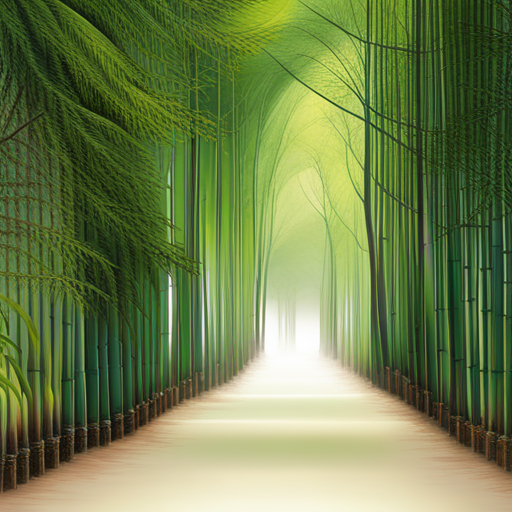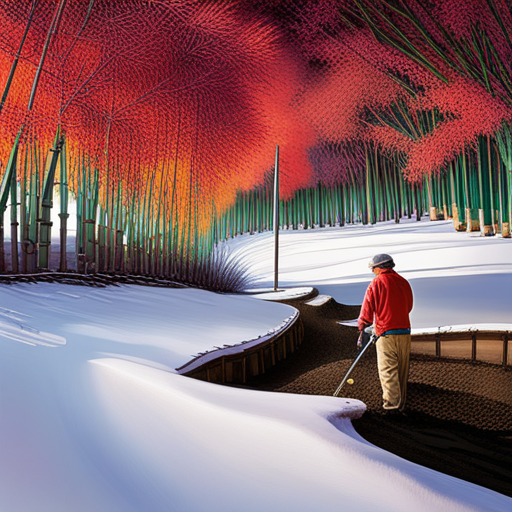Cold Hardy Bamboo: Ideal for Ohio Gardens
Bamboo gardens and forests in the USA are largely undiscovered natural wonders. However, Ohio’s challenging climate, with temperatures often dipping below freezing, requires resilient and adaptable plant species that can thrive in such conditions. Cold hardy bamboo varieties offer an ideal solution for Ohio gardens, even in areas classified as USDA plant hardiness Zone 5 or 6. These bamboos not only withstand freezing temperatures but also add beauty and functionality to the landscape.
For ornamental purposes and privacy screens, clumping bamboos such as Fargesia robusta ‘Wolong’ and Fargesia dracocephala ‘Rufa’ are excellent choices. Alternatively, running bamboos like Sasa veitchii and Indocalamus tessellatus can rapidly fill large areas, though local regulations should be checked as planting running bamboo may be prohibited in certain municipalities. To control its growth, root barriers and regular maintenance are effective measures.
Proper care is crucial for the survival of bamboo in Ohio gardens. This includes protecting it from winter conditions and ensuring regular watering. Additionally, growing bamboo in containers provides easier maintenance and flexibility in landscape design.
With their cold hardiness and diverse varieties, bamboo proves to be a valuable addition to any Ohio garden, adding both aesthetic appeal and functionality.
Contents
- 1 Our Highlighted Points
- 2 Varieties for Zone 6
- 3 Care and Maintenance
- 4 Controlling Growth
- 5 What Makes Cold Hardy Bamboo Ideal for Gardens in Ohio?
- 6 Frequently Asked Questions
- 6.1 Can bamboo be grown in containers in Ohio gardens?
- 6.2 Is it possible to grow bamboo in shady areas in Ohio?
- 6.3 Are there any specific bamboo species that are drought-tolerant?
- 6.4 How can I assess and fix the problem if my outdoor bamboo is dying?
- 6.5 Are there any non-invasive clumping bamboo species that are suitable for privacy purposes in Ohio gardens?
Our Highlighted Points
- Cold hardy bamboo varieties suitable for Ohio’s climate can be grown in Zones 5 and 6.
- Clumping bamboos are ideal for ornamental purposes and privacy screens.
- Running bamboos are great for filling large areas quickly, but local regulations should be checked before planting.
– Proper care, including protection from winter conditions and regular watering, is crucial for bamboo survival.
Varieties for Zone 6

There are numerous cold hardy bamboo varieties suitable for Ohio’s Zone 6, such as Fargesia robusta ‘Wolong’ and Phyllostachys aureosulcata ‘Spectabilis’, which are known for their ability to form dense screens and provide ornamental value.
These varieties are the best options for Ohio gardeners looking to grow bamboo in colder climates.
When planting cold hardy bamboo in Zone 6, it is important to choose a location with well-drained soil and partial shade. Regular watering is necessary, especially during dry periods. Additionally, protecting the bamboo from harsh winter conditions, such as strong winds and heavy snow, is crucial for its survival.
Maintenance includes controlling the growth of running bamboo with root barriers and regular monitoring of rhizome spread.
By following these planting tips and maintenance practices, Ohio gardeners can successfully grow and enjoy cold hardy bamboo in their gardens.
Care and Maintenance

To ensure the health and longevity of the plant, proper care and maintenance are essential for the successful cultivation of cold tolerant bamboo varieties in Ohio gardens.
Winter protection is crucial for bamboo survival in cold climates. Mulching around the base of the bamboo plant with a thick layer of organic material can help insulate the roots and protect them from freezing temperatures. Additionally, covering the bamboo with burlap or a frost cloth during extreme cold spells can provide extra protection.
Regular watering is also important for bamboo, especially during dry periods. It is recommended to water deeply and infrequently, allowing the soil to dry out slightly between waterings. This helps promote healthy root development and prevents waterlogging, which can lead to root rot.
By implementing these winter protection and watering techniques, gardeners can ensure the successful growth and maintenance of cold hardy bamboo in Ohio gardens.
Controlling Growth

One method for managing the growth of bamboo in colder climates is the use of root barriers and regular maintenance. By installing a root barrier, such as a 30 mil by 24 inch barrier, around the bamboo, its rhizomes can be contained and prevented from spreading uncontrollably. It is important to ensure that the barrier is tightly compacted with the soil to prevent any air pockets or loose soil that may allow the bamboo to escape.
Another method for controlling bamboo growth is the trench method. By digging a shallow trench around the bamboo and checking it periodically, any rhizomes attempting to cross can be identified and cut off. This method requires regular maintenance, but it can effectively control the growth of the bamboo and prevent it from becoming invasive.
What Makes Cold Hardy Bamboo Ideal for Gardens in Ohio?
When it comes to gardening in Ohio, hardy bamboo varieties for Minnesota are an excellent choice. These cold-tolerant bamboos can withstand harsh winter conditions, making them an ideal addition to any garden. Their ability to thrive in low temperatures makes them resilient and suitable for the Ohio climate. Not only do they add a touch of elegance with their tall stature, but they also provide privacy and create a calming atmosphere. Whether you want to create a serene sanctuary or add a unique touch to your landscape, hardy bamboo varieties for Minnesota are a perfect fit for gardens in Ohio.
Frequently Asked Questions
Can bamboo be grown in containers in Ohio gardens?
Bamboo can be grown in containers in Ohio gardens, providing the opportunity to grow bamboo indoors. This method offers several benefits, including the ability to control the growth and spread of bamboo, easier maintenance, and flexibility in landscape design.
Is it possible to grow bamboo in shady areas in Ohio?
Bamboo can be grown in shady areas in Ohio, but it generally prefers full sun for optimal growth. When growing bamboo in shady areas, it is important to choose bamboo species that are tolerant of lower light conditions. The best soil types for growing bamboo in Ohio are well-draining soils with good fertility.
Are there any specific bamboo species that are drought-tolerant?
Drought-tolerant bamboo species are available, making them suitable for dry conditions. When considering the best bamboo for such environments, it is important to select varieties specifically known for their ability to withstand drought and require less water.
How can I assess and fix the problem if my outdoor bamboo is dying?
To assess and fix the problem of outdoor bamboo dying, examine the plant for signs of stress such as yellowing leaves or fungal growth. Identify the cause, which could be over or under watering, inadequate sunlight, or pests. Adjust watering and sunlight levels accordingly, treat any pests, and provide appropriate care to revive the bamboo.
Are there any non-invasive clumping bamboo species that are suitable for privacy purposes in Ohio gardens?
There are several non-invasive clumping bamboo species suitable for privacy purposes in Ohio gardens. These species offer the benefits of privacy while being easier to maintain. Proper care and maintenance, such as regular watering and protection from winter conditions, are essential for their survival.

